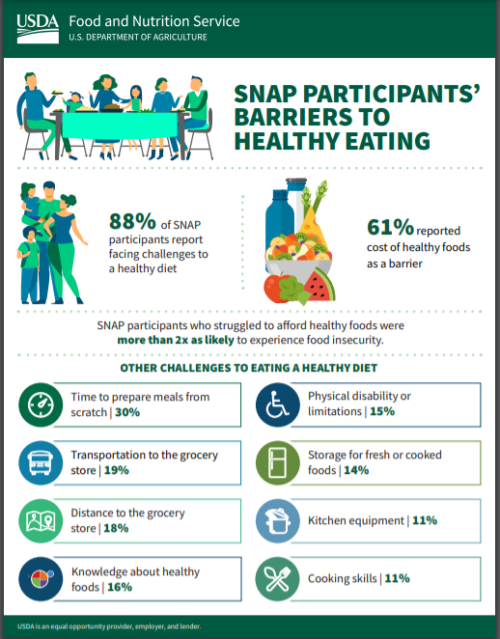I’m giving the opening keynote address at this meeting at 4:15 p.m. It’s also online. For information, registration, and online access, click here.
My talk: “The Elements: Food, Nutrition, Health & Politics, 2025 Style.”

Let’s hear it for USDA. It’s asking tough questions about its programs and paying attention to what it’s finding out.
It has just issues a report on barriers to eating healthfully on SNAP (formerly, Food Stamps).
The press release summarizes the report.
The study, Barriers that Constrain the Adequacy of Supplemental Nutrition Assistance Program Allotments, conducted in 2018, finds that 88% of participants report encountering some type of hurdle to a healthy diet. The most common, reported by 61% of SNAP participants, is the cost of healthy foods. Participants who reported struggling to afford nutritious foods were more than twice as likely to experience food insecurity. Other barriers range from a lack of time to prepare meals from scratch (30%) to the need for transportation to the grocery store (19%) to no storage for fresh or cooked foods (14%).
An infographic displays this information.

The report comes in three parts:
From the interviews (page 52)
Overview
More broadly, processed foods—both those purchased at stores for home consumption and those eaten out—were seen as cheaper than healthier options…This perception was the same whether participants lived in urban or rural areas, had children or elderly in the household, or spoke Spanish or English.
Two interview excerpts
Just kind of life circumstances and it makes no sense to me that it is terribly cheap to eat like crap. Eating at [fast food ] every day is going to cost me $5 today and I would eat every day $5 a day but if I tried to go to [store] or some place that had good food and buy good food for a day, even just for myself, for $5, not going to happen. It’s going to be triple that or quadruple that or 10 times that depending on where you go.
Oh, just not processed. Not processed, not frozen. And I don’t really think carbs are very healthy myself, like breads and pastas, I don’t find necessary really. That’s mostly what you can afford, is the cheapest, for some stupid reason in stores, you know?
Policy options seem pretty obvious. I hope USDA gives them a try.